This compilation is a result of several years of observation, reading books on the topic, and interacting with experts and other like-minded people. The effort started with a series of postings on bngbirds as and when I observed a species in bloom. In the process about two dozen species were covered. Due to popular request from several subscribers to bngbirds this series was repeated with some additions. And recently the same content was suitably edited and posted on www.wildwanderer.com. Here again, it met with an overwhelming response. This prompted and encouraged me to add some more species taking the total to over 50 species.
Albizia lebbeck
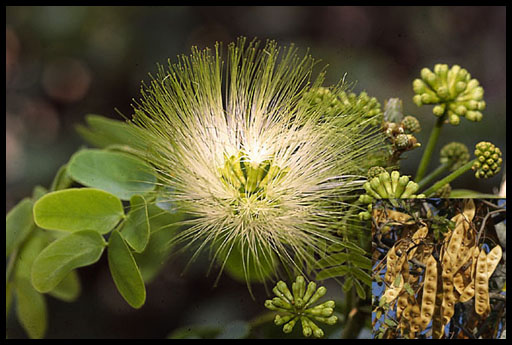
Common Name :Woman’s Tongue Tree
Origin :Tropical Africa, Asia, and northern Australia
Flowering Season : April-May
Vernacular Name :Baage
Brief Description : This tree is particularly noticeable after the flowering is over and the tree bears the large, light brown flat pods. The pods hanging in good numbers on the tree can be seen during the winter months. These make a loud rustling noise when subject to even a gentle breeze giving the tree its common name. The greenish white flowers of this tree are very pretty, reminiscent of the Rain Tree; they also have a mild fragrance. The tree can be easily propagated by seed.
Species of Grassyellow Eurema sp. butterflies use this as their larval host plant.
Anthocephalus cadamba
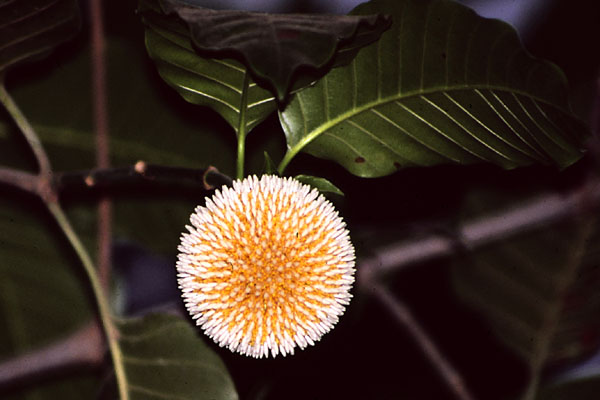
Common Name : Common bur-flower
Origin :India, China, Australia, Indonesia, Malaysia, Papua New Guinea, Philippines, Singapore, Vietnam
Flowering Season :October to July
Vernacular Name :Kadamba
Brief Description : This tree has large leaves arranged loosely and therefore not forming a dense canopy. The tree grows large with spreading branches and is unfit for planting in small spaces. However, it is ideally suited for large parks, gardens and campuses. The flowers somewhat resemble the Badminton Ball tree. This tree has been planted as an avenue tree in some parts of Bangalore.
The Commander Limenitis procris butterfly uses this as their larval host plant.
Brassaia actinophylla
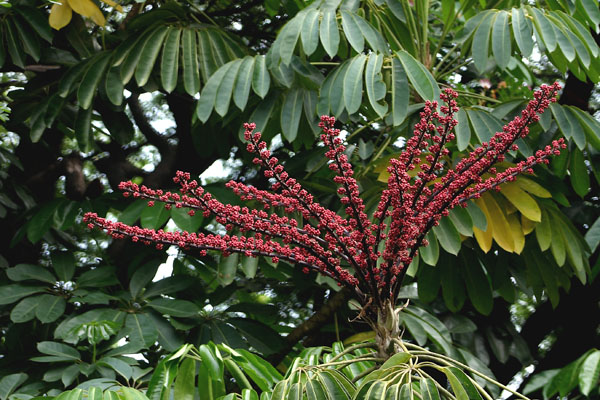
Common Name :Umbrella Tree or Octopus Tree
Origin :Australia
Flowering Season :February-March
Vernacular Name :None
Brief Description :The large palmate leaves are very characteristic and make the tree particularly noticeable. It generally takes a long time before the tree can boast of a substantial canopy. Nevertheless, this evergreen tree looks pretty. Both the common names for the tree are very apt. The name ‘Umbrella Tree’ is due to the leaf formation while the name ‘Octopus Tree’ can be attributed to the inflorescence.
Butea frondosa
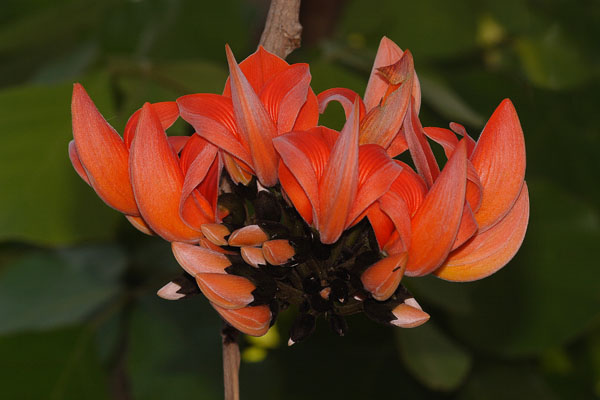
Common Name :Flame of the Forest
Origin :India and Burma
Flowering Season :January – March
Vernacular Name :Muttuga
Brief Description :This tree when in bloom is indeed a sight to behold, particularly so when the forest around it is dry and most trees bereft of leaves. The Flame of the Forest too, like many other trees that share the habitat sheds most of its leaves before putting forth the bright, yet pleasing, orange flowers arranged that are placed in clusters on its branches. The flowers are visited by a host of organisms – birds and butterflies. An early morning birding session in the vicinity of this tree during its flowering season is rarely disappointing. It can be propagated from seeds. Some Lycaenids Gram Blue Euchrysops cnejus, Pea Blue Lampides boeticus, Common Cerulean Jamides celeno and Dark Cerulean Jamides bochus (Blues – Family Lycaenidae) use this tree as their larval host plant.
In Bangalore there are very few of these trees including a couple in Lalbagh.
Careya arborea
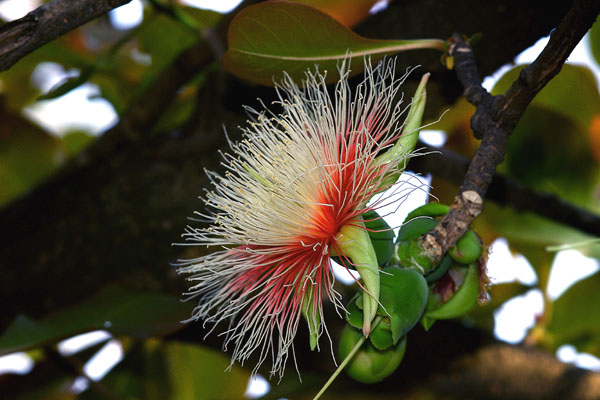
Common Name :Slow Match Tree
Origin :Afghanistan, Pakistan, India, Nepal, Burma, Malay Peninsula, Thailand, Laos
Flowering Season :March – April
Vernacular Name :Kavala
Brief Description :A nondescript tree with large leathery leaves. However, during the flowering season the tree sheds its leaves and bears large showy flowers. The flowers have several stamens which sometimes have red at their base. Soon after the flowering is over the tree puts forth new leaves. And, the large fruits of this tree remain until much later and well into the rainy months. The fruit is supposed to be edible. The tree can grow in open areas as it requires a lot of sunlight. The tree itself is propagated by seed.
In the forests where the tree occurs the larvae of a butterfly called the Grey Count Tanaecia lepidea feed on this tree.
Cassia fistula
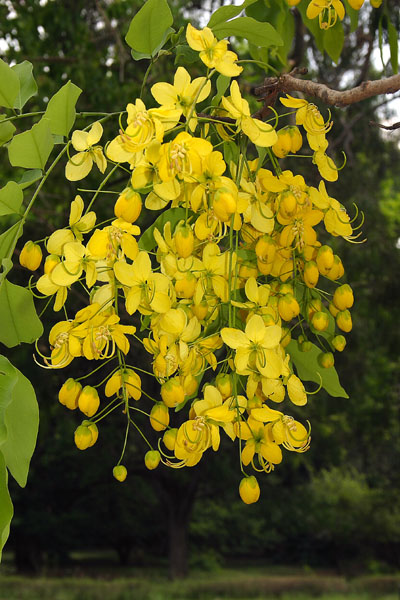
Common Name :Indian Laburnum or Golden Shower
Origin :India, Burma and Sri Lanka
Flowering Season :February to March
Vernacular Name :Kakke mara
Brief Description :The inflorescence of golden yellow flowers borne on green stalks resembles a chandelier. Butterflies Emigrants Catopsilia sp. and the Grassyellows Eurema sp. belonging to Family Pieridae choose the tender leaves of this tree to lay eggs on. Also characteristic are the pods of this tree which could be up to two feet in length. Each seed, encapsulated in a sweetish pulp is housed in a separate compartment within the foot-long pod. The pulp is said to have mild laxative properties and is also a favourite of the sloth bears. It is propagated from seed with some difficulty.
This moderately sized tree is truly spectacular when in bloom. The tree has somewhat sparse foliage. All of these make it an excellent tree for ornamental purposes.
Cassia spectabilis
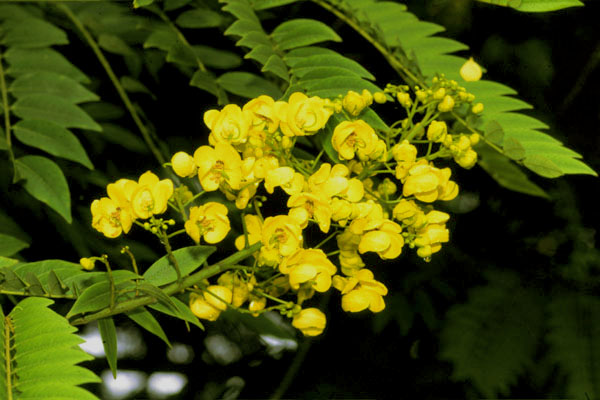
Common Name :Golden Cassia
Origin :Central America and the Northern regions of South America
Flowering Season :September – November
Vernacular Name :None
Brief Description :This is a Cassia with a spreading canopy. It is also short in stature. The large inflorescences are held above the canopy and are produced when the tree has leaves. The combination of green and yellow is quite spectacular when the tree is in bloom. All these features make it well suited for landscaping and also for planting especially in parks and gardens.
Cochlospermum gossypium
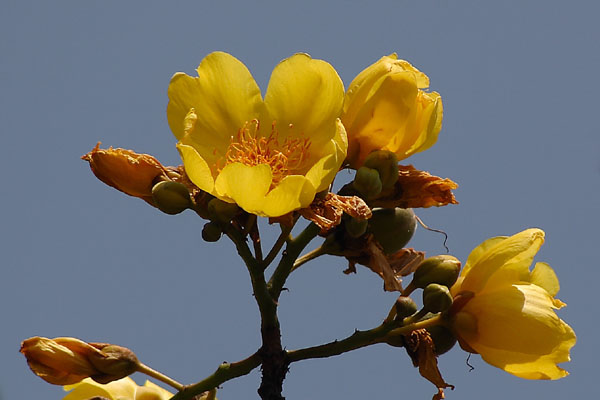
Common Name :Yellow Silk Cotton
Origin :India, Burma and some islands of the Far East
Flowering Season :February – March
Vernacular Name :Arasinabooruga
Brief Description :The Yellow Silk Cotton is a small deciduous tree with a stout trunk. It grows wild in peninsular India, in the dry hilly tracts, which is its habitat. The foliage of the tree is sparse but the large bright yellow flowers borne in terminal clusters are hard to miss; more so since they are in bloom when the tree is devoid of leaves. The fruit is a large capsule that turns reddish when dry; the seeds are embedded in short silky wool.
The Yellow Silk Cotton is propagated from seed.
Cordia sebestena
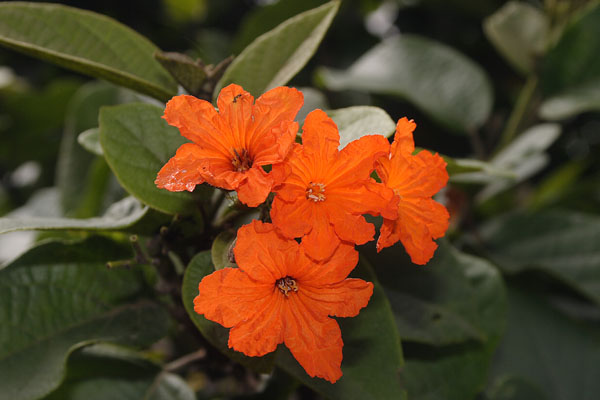
Common Name :Scarlet Sebesten
Origin :Caribbean
Flowering Season :Throughout the year; peak between January and March
Vernacular Name :Kempuchalle
Brief Description :An evergreen tree with medium sized rough leaves; it can be planted in full sunlight. This tree has a small stature and has a long flowering season. The foliage is not dense. All these features not only make the tree look attractive throughout the year but also make it well suited for large home gardens and parks. It is much sought after for landscaping, particularly where dense foliage is not preferred.
Dolichandrone platycalyx
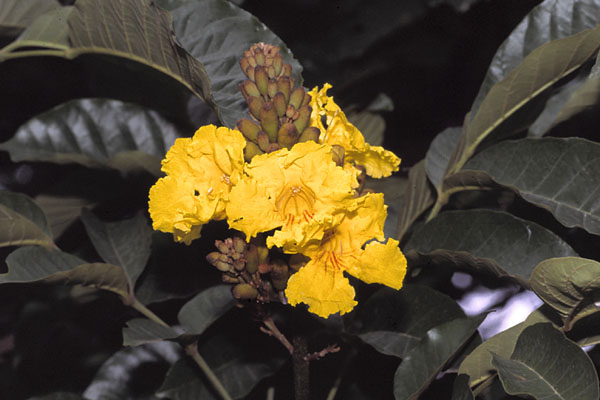
Common Name :Nile Tulip Tree
Origin :East Africa
Flowering Season :Most of the year
Vernacular Name :None
Brief Description :Now it is known scientifically as Markhamia lutea. This tree grows tall; and does not branch very much. The tubular yellow flowers are borne in clusters and are very attractive. After the flowering season one can see long pods hanging on the trees. As the pods turn brown, they become twisted. These pods, in excess of a foot and half in length, remain on the tree for a long time.
This is a good tree to plant in narrow spaces since it tends to grow tall and does not branch out much. It is suitable for parks, gardens, and avenues.
Enterolobium cyclocarpum
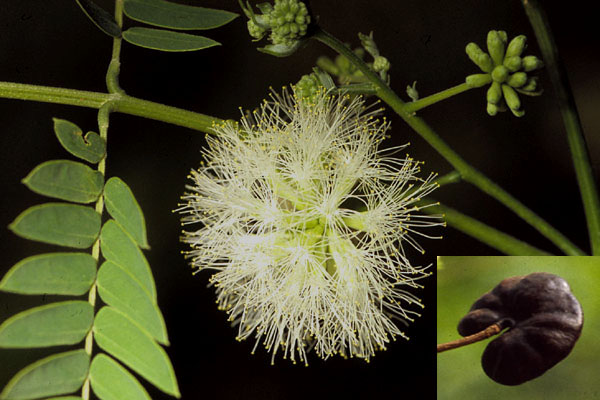
Common Name :Elephant Ear Tree
Origin :Mexico, Central and South America
Flowering Season :February to April
Vernacular Name :None
Brief Description :This tree grows large and bears flowers that are small and somewhat similar to those of the forget-me-not. It flowers in profusion during the season, to the extent that the ground below the tree almost turns white. The pods are large, dark brown in colour and each pod spirals so as to produce a disk like structure. The foliage is fine and feather-like with a spreading crown and is an ideal shade tree. A few of these trees can be seen in Bangalore. There are fine examples in Cubbon Park, and a large tree in Krishna Rao Park next to the Basavangudi Police Station.
Erythrina indica
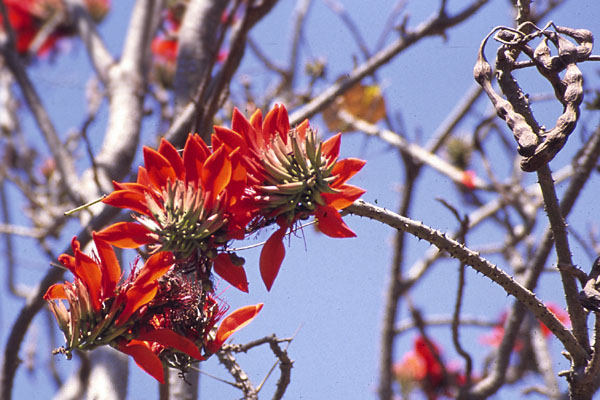
Common Name :Indian Coral Tree
Origin :Eastern Africa, Southern Asia, Northern Australia, and islands of the Indian Ocean
Flowering Season :February – March
Vernacular Name :Halvana
Brief Description :This tree, like many others sheds all its leaves when in bloom. The bright red blossoms attract a good lot of birds. The fruits remain on the tree almost through the year. The seed in the pod is a deep reddish-brown. Rub the seed (on the side with the dimple) on a smooth cement floor and put it on your skin; you will realise the amount of heat it can generate! A word of caution, the seed can turn quite hot enough to leave a bad burn on the skin.
Several other species of Erythrina can also be seen. Erythrina suberosa is seen on the outskirts of the city and in drier areas, while Erythrina crista-galli can be seen in gardens and parks as it is used in landscaping. The tree can be propagated by seeds and by cuttings.
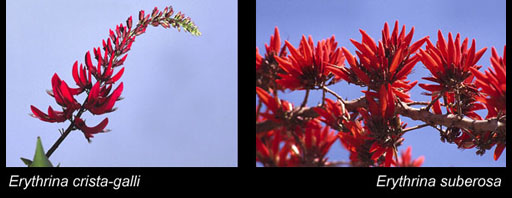
Michalea champaca
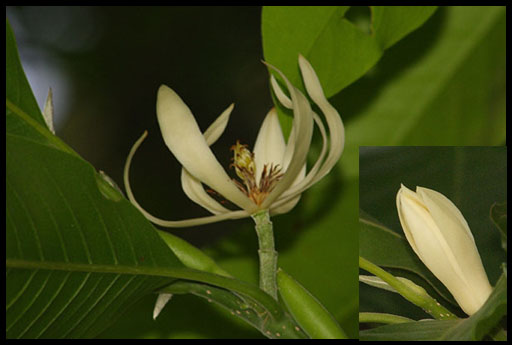
Common Name :Champak
Origin :South Asia and Southeast Asia. In India – sub-Himalayan tracts; lower hills up to 3,000 ft., Assam, Burma, Western Ghats, southern India.
Flowering Season :May – December
Vernacular Name :Sampige
Brief Description :This evergreen tree does not need any introduction. It is largely cultivated for its fragrant flowers. It is very well known to people as they use its flowers for religious ceremonies. Frequently planted in the vicinity of temples, it is considered sacred. The tree requires moderate amount of sunlight and does well in moist climate. This tree has reasonably dense foliage and can grow very large.
The Common Jay Graphium doson butterfly uses the leaves of this tree as its larval host plant.
Plumeria sp.
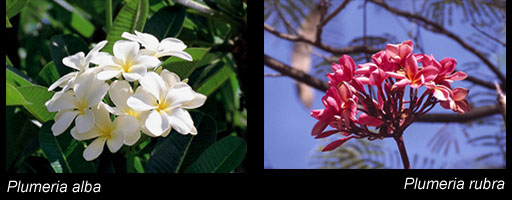
Common Name :Frangipani, Temple Tree, Pagoda Tree
Origin :West Indies, Mexico
Flowering Season :February to October
Vernacular Name :Kaadusampige
Brief Description :There are 2 species of Temple Trees that are met with often. The Red Frangipani Plumeria rubra which is a somewhat odd-looking tree while the White Frangipani Plumeria alba is the more handsome. Both are of small stature; the former being deciduous and the latter evergreen. They both have leaves that are thick. The leaves and the stem exude a white milky substance when injured. Both, the Red and the White Frangipanis, bear fragrant flowers in clusters at the tips of their branches. These trees are planted in gardens and parks and often used in landscaping.
The trees are easily propagated from cuttings. There are several hybrids of these Frangipanis.
Pterospermum acerifolium
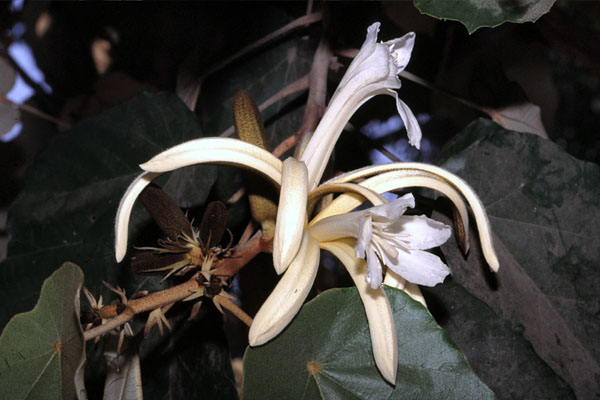
Common Name :Dinner Plate Tree
Origin :India; Bangladesh; Bhutan; Nepal, Myanmar; Thailand
Flowering Season :February – March
Vernacular Name :Naradu
Brief Description :This tree is also popularly known as Kanaka Champa. The flowers are white with long narrow petals. The sweet-scented flowers open at night and fall by morning; the flowers are pollinated by bats. The name Pterospermum means winged seeds. The brown coloured winged seeds fall out of large woody capsules which mature after remaining on the tree for almost a year.
This medium sized evergreen tree is a native of the Himalayan foothills. It is planted in many other parts of the country in parks and gardens as it can be propagated from fresh seeds.
Santalum album
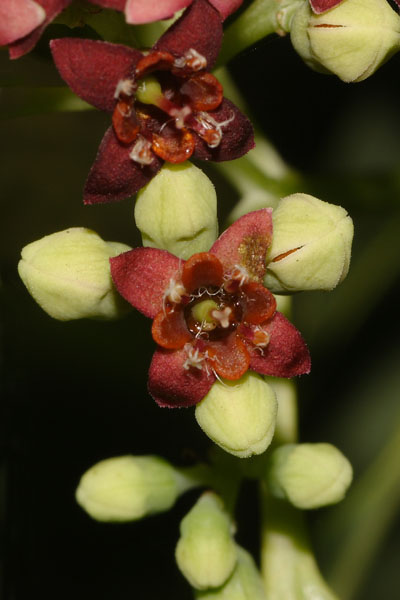
Common Name :Sandal Wood Tree
Origin :India
Flowering Season :Throughout the year; mainly February – May
Vernacular Name :Gandhada mara
Brief Description :The Sandalwood is an evergreen tree. The tree, in its living form, has no fragrance much to the contrary to what people often expect. The tiny flowers are greenish to begin with and turn maroon eventually; they can be easily overlooked. The fruits are green when raw and become blackish when ripe. At this stage the koels throng the tree. These birds are also perhaps among the important seed dispersal agents of the tree. The somewhat closed foliage also affords ample cover to the shy Koel.
Saraca asoca
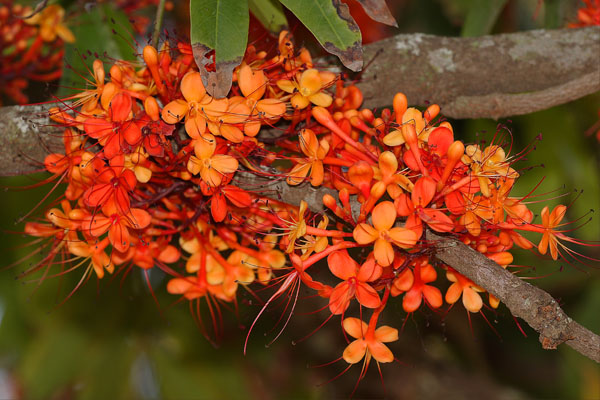
Common Name :Ashoka Tree
Origin :India, Sri Lanka, Myanmar and Malayasia
Flowering Season :Throughout the year; mainly November – March
Vernacular Name :Ashoka
Brief Description :This is a small sized evergreen tree with spreading branches and a dense foliage of medium sized leaves. If planted in an open area, it assumes a well proportioned, round canopy. The flowers are borne on dry branches in dense clusters that are orange-red that deepens as they age. The tree looks particularly attractive when in bloom.
This tree is also associated with mythology. Besides, it is attributed with a lot of medicinal properties. It is propagated by seeds.
Swietenia macrophylla
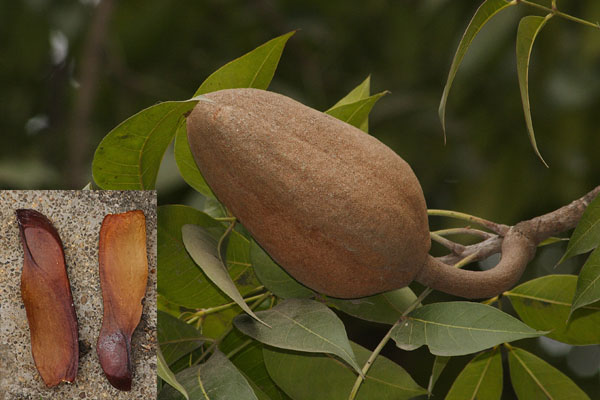
Common Name :Large-leaved Mahogany
Origin :Caribbean; West Indies
Flowering Season :March – April
Vernacular Name :Mahogany
Brief Description :The flowers of this tree are very tiny and hardly noticeable when on the tree. But one can see these pale greenish flowers scattered on the ground beneath the tree. However, the strong yet pleasant fragrance in the vicinity of the tree in flower gives it away. It is quite an experience to be beneath a mahogany in flower on a summer morning or in the evening. At this time, the tree also sports fresh leaves which are shed very briefly during December through January. The seeds of mahogany are familiar to every one due to its dispersal method. The seeds are brown and have a long flat wing and are neatly arranged and enclosed in a woody capsule. These seeds can be used for propagation.
There are a few avenues in Bangalore lined with this tree. The road running parallel to the park with the statues of the Queen and the King in Cubbon Park (opposite the stadium) and the Diagonal Road leading to Jayanagar 4th Block (the road with the Police Station) are just two roads which are lined by this tree.
Syzygium cumini
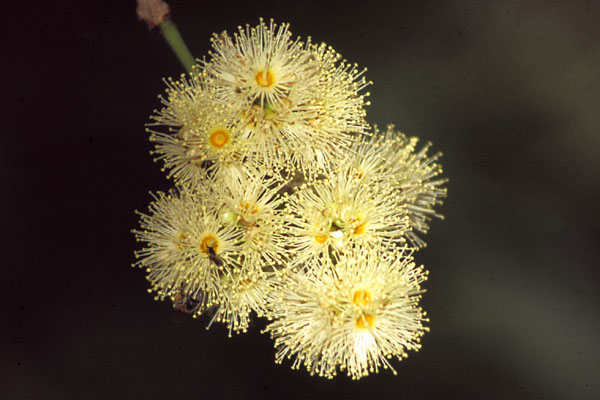
Common Name :Jamun or Java Plum
Origin :India, Burma, Ceylon and the Andaman Islands
Flowering Season : February – May
Vernacular Name :Nerale mara
Brief Description :Many city folk, perhaps, would have eaten the fruits of this tree without knowing what the tree looks like. This is a large evergreen tree. Being a native, it can support a lot of life. When the tree puts forth its small whitish flowers, bees are attracted to it. Besides, being a tree with dense foliage it can also support a good number of birds like the barbets, mynahs, and a whole lot of others even in the urban area. The fruits are green when raw and turn deep blackish purple when ripe; fruits have a layer of pulp over a large single seed and are edible.
Thespesia populnea
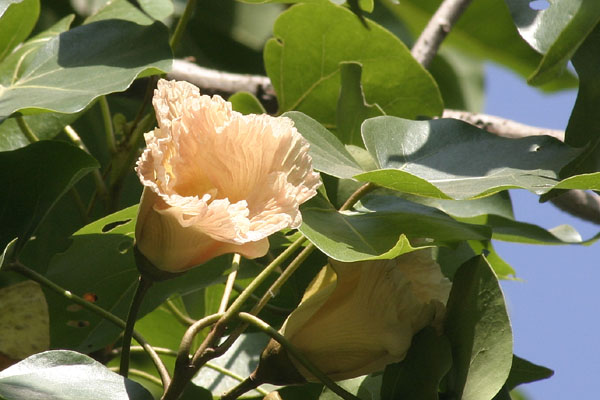
Common Name :Portia tree or Bhendi tree
Origin :Coastal forests of India and Burma; tropical Asia, Africa, and the Pacific Islands
Flowering Season :Almost throughout the year peaking during winter
Vernacular Name :Huvarasi
Brief Description :Often planted as a roadside tree; particularly common in Tamil Nadu. The Portia tree is a tree that grows to about 30-40 feet in height. Leaves are broad and somewhat reminiscent of the leaves of the Peepul and are heart shaped with prominent veins. The tree, being a relative of the Hibiscus, has flowers similar to it too. They are large crumpled looking flowers with an exterior yellow colour and a deep reddish centre. The flowers turn reddish as they age. The fruit is a capsule with a rounded shape, somewhat like a top.
The tree is propagated from cuttings and is known to grow rapidly. It is also easily grown from seed.
Click here to buy your copy of the pocket sized Discover Avenue Trees